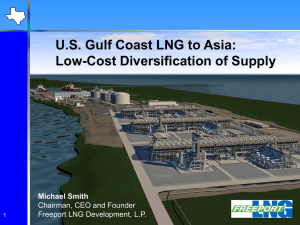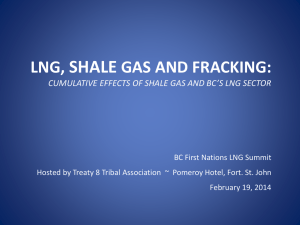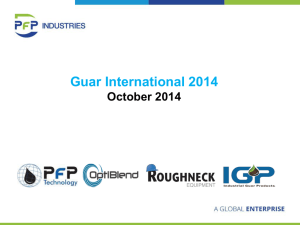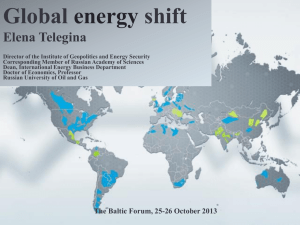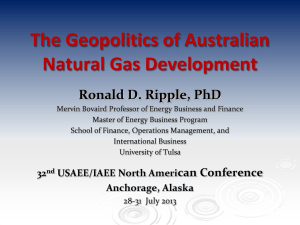RWGTM Presentation
advertisement
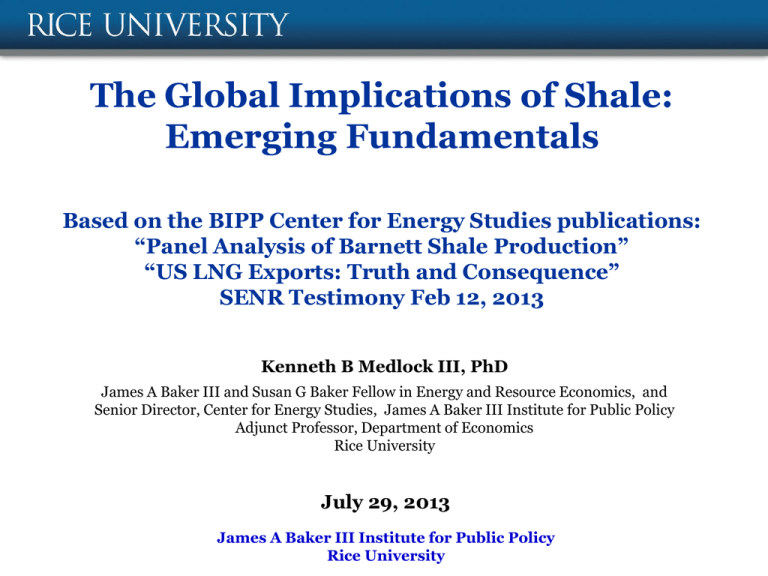
The Global Implications of Shale: Emerging Fundamentals Based on the BIPP Center for Energy Studies publications: “Panel Analysis of Barnett Shale Production” “US LNG Exports: Truth and Consequence” SENR Testimony Feb 12, 2013 Kenneth B Medlock III, PhD James A Baker III and Susan G Baker Fellow in Energy and Resource Economics, and Senior Director, Center for Energy Studies, James A Baker III Institute for Public Policy Adjunct Professor, Department of Economics Rice University July 29, 2013 James A Baker III Institute for Public Policy Rice University The “50,000 Foot” view in 2000: LNG is coming to North America The difference a decade makes: Over 6,600 tcf of technically recoverable shale* Major North American Shale Plays (~1,930 tcf) European, Latin American, African and Pacific Shale Plays (~4,670 tcf) *Over 6,600 tcf of shale according to ARI report, 2011 Far-reaching implications of shale gas • • • Expansion of production from US shale plays has rendered the utilization of LNG import capacity in the US very low. It has had an impact on the relative price of oil and gas, and … it has raised the possibility of US LNG exports. - - • • Domestic price impacts have been a central concern. This opportunity may be highly contingent on the value of the US dollar. When weighing all demand responses, and thus market impacts, the focus should not be on just exports. Current and future expansion of shale gas in the US, Europe and Asia makes the global gas supply curve more elastic. - This mitigates the potential for sustained long term increases in price. Greater supply elasticity also pressures traditional pricing paradigms. 4 Modeling Well Decline in Shale Plays: Assessing the Long Term Possibilities “Panel Analysis of Well Production History in the Barnett Shale” 5 Implications for Production Sustainability • Well-specific EURs can vary within a shale play substantially - Ultimately, profitability matters, as there is little debate about resource scale - Some wells are profitable at $2.65/mcf, others need $8.10… median is $4.85. EUR 2.83 bcf 1.51 bcf 0.93 bcf 6 What does the global supply picture look like? 7 EURs in Shale Plays • EURs estimated using geologic data for active shale plays in North America and econometrically fit for RoW shales. – Average EUR is modeled as a function of porosity, TM, TOC, Clay Content, GIP Concentration, Thickness, Depth... R2 = 0.875. • We “tier” the resources using a log normal distribution around the estimated mean EUR. The distributions are fit using US analogs. 8 A snapshot of long run development costs • In addition to EUR, we need estimates of drilling and completion costs. These are econometrically fit to drilling depth and reservoir pressure for known North American plays. • Development costs in the following tables are long run costs. - As such, the costs indicated are representative of costs when all short run constraints on rig availability, frac’ing crews and equipment, qualified personnel, etc. are relieved. As such, it should be noted that the first entry cost in many regions may be considerably higher. o A 10,500 ft well (TVD) with a 4,000 ft lateral in the Haynesville shale in the US will typically cost around $8 million. o The same well right now in Poland will cost in the $14-16 million range. o Notice this changes the perception of commercial viability, but costs should fall as activity ramps up due to the mobility of capital, labor and technology. o The transition can be tricky and will in many cases depend on local policies. 9 So what about the foreign opportunities for shale? Not as Fast. The US is Unique. • Stable and conducive regulatory and institutional frameworks. - Resource Access – mineral rights ownership; acreage acquisition; resource assessments; environmental opposition; etc. - Market Structure – transportation regulation (unbundled access vs. incumbent monopolies) and bilateral take-or-pay obligations vs. marketable rights; existence of infrastructure; pricing paradigms; etc. • Many other issues face shale development. - Water – use in production; water rights and management; flowback options (recycle and/or treatment and disposal) and native infrastructure; concerns about watershed protection (casing failures and fracture migration); etc. - Other issues – earthquakes related to injection of produced and treated water; long term effects of methane escape; concerns about contamination from produced water; ecological concerns over land use and reclamation; etc. • There are other supplies that may not face the same impediments - East Africa, Australia, Russia… 10 Margins of Demand Response and The Prospect of US LNG Exports 11 Domestic Price Impacts of US LNG Exports • Common claim: US price will increase substantially – Only true if US domestic supply is highly inelastic (pictured below) and foreign supply is highly elastic (not pictured). This claim is unlikely. The Elasticity of Domestic Supply and the Impact of Exports on Price P Demand increase due to exports P Price increase due to exports Demand increase due to exports Price increase due to exports Q Case 1: Supply elastic Q Case 2: Supply inelastic 12 Impact of Shale on Henry Hub, 2011-2040 • The domestic supply curve is much more elastic as a result of shale gas developments. Domestic long run elasticity* - with shale = 1.52; without = 0.29. * - Results derived from the Rice World Gas Trade Model (RWGTM). The RWGTM was developed by Ken Medlock and Peter Hartley at Rice University using the MarketBuilder software provided by Deloitte MarketPoint . 13 Price Impacts of US LNG Exports: Introducing the Foreign Market Response • When trade between two markets is introduced, price in each adjusts. The adjustments will depend on the relative elasticities Domestic and Foreign Market with Trade of supply and demand. P P S’ S S’+ m Tf Td P Imports, m P Exports, x D’ D D+x Q Q Domestic Market Foreign Market 14 The Impact of US LNG Exports • Lots of attention given to current international spot price, but several factors are often ignored, such as - short term capacity constraints, which are important when considering where we are today, - domestic market interactions with markets abroad, and - a weak US dollar. • “Spot” price of natural gas in Asia changed after Fukushima. • US LNG exports could put significant downward pressure on international price. - In 2011, LNG trade was about 32 bcfd. Current filings exceed 30 bcfd. • Effects of international trade are contingent on both domestic and foreign elasticities of supply and demand. 15 International Prices • Will the change in regional gas price relationships since March 2011 persist? - Unexpected demand shocks have had an influence. It is reasonable to expect that US price will rise to reflect marginal cost and JKM premium will subside with relief of deliverability constraint Price data from Platts; LNG Oil-Index author’s calculation 16 A Longer Term View of Prices • The recent divergence is new… but can it persist? Or, is it a result of short term constraints? Interest in LNG exports Interest in LNG imports Sources: Compiled from Platts, IEA, EIA 17 Contracts and Liquidity • Absent storage and physical The Supply Curve Effect of Shale and Implications for Price liquidity, oil indexation P provides an element of price certainty. Implied additional rents associated with existing • Oil indexation is a form of price contracts discrimination - (1) Firm must be able to distinguish consumers and prevent resale. (2) Different consumers have different elasticity of demand. • Increased ability to trade between suppliers and consumers (physical liquidity) violates condition (1). - This will happen in a liberalized market, or as LNG trade grows, or as hubs emerge in end-use markets. S POIL INDEX S ’ P@ P=MC Effect of shale on the supply curve Oil Indexed Contract Volume Total Volume “Spot” Volume D Q 18 Contracts and Flows • Atlantic Basin LNG diverted… - short term volumes expand • … Pacific Basin LNG expands. - short term volumes expand Data Sourced from the International Group of Liquefied Natural Gas Importers (GIIGNL) 19 Exchange Rate Effects • Another factor that is important to the export issue is the exchange rate. In fact, this matters for US industrial sector competitiveness as well. - Exchange rate impacts: PUS PUK XR HR arb value Trade-Weighted Value of US $, Major Currencies (Daily, Jan 1973 – Jan 2013) Source: US Federal Reserve Bank 20 Final Comments on US LNG Exports • Export capacity will be built on the expectation that current rents from arbitrage will “pay” for the upfront fixed cost. - But, once the fixed cost is sunk, operation no longer hinges on the payment to capital. It is possible that some terminals will not earn the ex-ante required rate of return, contingent on the off-take agreement. - Project success is contingent on where the contractual risk falls. • US LNG export capacity could be used for seasonal arbitrage. While the annual load factor would be lower in this circumstance, if seasonal price differences among the regional markets are sufficient, US exports could be profitable. • LNG exports from the US, even in small volumes, will link global markets to storage in the US. By providing this link, liquidity benefits could spill over and contribute to very different market paradigm. 21 What about other domestic demands? • What are the end-uses where demand could change? - Power generation Industrial uses as an energy source and feedstock Automotive transportation – personal and commercial Marine transportation – EPA forcing out heavy fuel oil and diesel LNG and pipeline exports (foreign demand for US gas) • Incremental demand responses (by 2020 - 35 bcfd) LNG exports (12 bcfd) Power generation (10 bcfd) Industrial uses (7 bcfd) Automotive transportation (2 bcfd) Marine transportation (2 bcfd) Pipeline exports (2 bcfd) 22 What about other domestic demands? • What are the end-uses where demand could change? - Power generation Industrial uses as an energy source and feedstock Automotive transportation – personal and commercial Marine transportation – EPA forcing out heavy fuel oil and diesel LNG and pipeline exports (foreign demand for US gas) • Incremental demand responses (by 2020 - LNG exports (12 bcfd) < 4 bcfd – market Power generation (10 bcfd) < 5 bcfd – policy and market Industrial uses (7 bcfd) < 3 bcfd – market Automotive transportation (2 bcfd) < 0.25 bcfd – market Marine transportation (2 bcfd) < 2 bcfd – policy Pipeline exports (2 bcfd) < 2 bcfd – market • Scale of demand increase - 35 bcfd) < 16 bcfd – RWGTM modeled outcomes … or up to 25% of current demand. (Note: Res/Comm falls by >1.5 bcfd) 23 Questions/Comments 24 A Fully Integrated Modeling Outcome • Henry Hub remains below the relationship that persisted historically, although the Asia price and NBP grow slightly closer. Notice the margin for profitable US exports grow very thin… Sources: Compiled from Platts, IEA, EIA and RWGTM 25 What about Price Volatility? • • • • Common claim: If we allow LNG exports we will import oil price volatility. The premise here is that crude oil is more volatile than natural gas. Is it? Economic theory predicts this. The more fungible (or tradable) a commodity is, the lower its price volatility, all else equal. Is the term being misused? (Volatility vs. forecast accuracy?) 26

